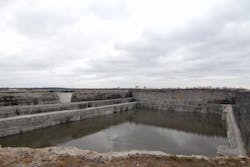Thornton Reservoir Takes in Combined Sewer Overflow for First Time
The Metropolitan Water Reclamation District of Greater Chicago's (MWRD) new Thornton Composite Reservoir has come to the aid of local waterways and area basements by capturing 400 million gal of combined sewer overflow. The level reached 17 ft and 5% of the reservoir's capacity.
The reservoir, located in the south suburbs near South Holland just north of the Tri-State Tollway (I-294), will benefit 556,000 people in 14 communities, including the South Side of Chicago and south suburbs. It will protect 182,000 homes, businesses and other facilities and improve water quality in the Calumet Rivers and Calumet-Sag Channel by collecting combined sewer overflows before entering waterways. The new reservoir holds these overflows before pumping the water 5.5 miles back to the Calumet Water Reclamation Plant for treatment.
Major construction connecting the reservoir to the tunnel was completed in September. Following gate installation, testing and waiting for rain, the complete reservoir system is online and can take in up to 7.9 billion gal of water.
The 1,300-ft tunnel meets up with the existing, operational deep tunnels. After installing the gates, crews had to remove a 10-ft-thick concrete mass separating the live tunnel from the reservoir. At 1,000 ft into the tunnel, the tunnel size transitions from 30 ft in diameter and splits into two massive tunnels that each house two thick wheel gates that can withstand 300 ft of water pressure and isolate the tunnels from the reservoir when necessary. Each of the four gates weighs approximately 100 tons.
A concrete apron constructed in front of the tunnel is designed to withstand the force of the water coming out of the tunnel, which can be at velocities of up to 30 ft per second, preventing erosion of the stone reservoir floor. Solar-powered aerators were installed in the reservoir and will float up and down with the water elevation, keeping the surface layer of water from going septic and causing odors.
Source: Metropolitan Water Reclamation District of Greater Chicago
